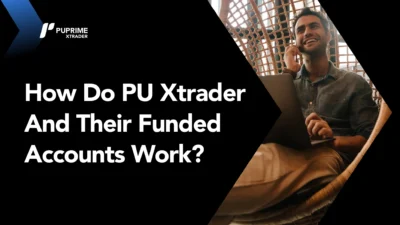Join the PU Xtrader Challenge Today
Trade with simulated capital and earn real profits after you pass our trader assessment.
Join the PU Xtrader Challenge Today
Trade with simulated capital and earn real profits after you pass our trader assessment.
21 December 2023,07:14
BlogFeatured
Understand the basics of proprietary trading and how prop trading firms operate. Learn some of the prop trading strategies commonly used with a funded account.
Tags:
Proprietary trading, alternatively known as prop trading, stands out as a fascinating option in the fast-paced world of finance where possibilities abound. In this guide, we will delve into some of the important basics of proprietary trading, clarify its methodologies, examine the different prop trading strategies a prop trader can consider using to increase profitability, and consider the advantages you can receive when you get a funded trading account.

Content:
In the traditional sense, proprietary trading involves trading financial instruments with an investment firm’s own capital rather than that of clients. In essence, it’s the financial institution’s way of investing directly in the markets to generate profits for itself. However, in recent times, the forex industry has introduced a new model for prop trading: where independent traders pay a nominal fee for an assessment service. Should these traders prove their trading skills and pass assessment, the firm will then provide these traders with a large amount of capital to trade with, then sharing in the profits.
The main differences between prop trading and traditional trading can be summarized as follows:
Capital: In prop trading, firms provide capital to traders, allowing them to trade with more substantial sums of money. In traditional trading, individuals use their personal capital for trading.
Sharing of Profits and Losses: Prop traders participate in profit-sharing agreements with the firm. They receive a portion of the profits made from their trades. In contrast, traditional traders keep all the profits they make but are solely responsible for any losses incurred.
Access to Resources: Prop trading firms provide traders with access to advanced trading technologies, research, and other resources that can enhance their trading performance. Traditional traders must rely on their own resources.
Risk Management: Prop trading firms typically have risk management protocols in place to monitor and mitigate risks. Traditional traders are solely responsible for managing their own risks.
These differences make prop trading an attractive option for traders looking to leverage the resources and capital of a firm, while traditional trading suits individuals who prefer to trade with their own funds and have full control over their profits and losses.

At its core, trading is a game of statistics. No trader wins all the time, and the best traders are those that can consistently improve their chances of making successful trades through discipline and a clear strategy. Forex Prop Trading firms are looking for these traders to fund, and incentivise them by usually sharing in the profits generated from trading.
However, because these firms are giving out access to their funds, a fair amount of risk control needs to be in place. Traders that have passed assessment are usually given demo accounts that simulate real conditions, while the firm’s corporate accounts copy selected trades in the back. Additionally, traders have to trade within certain parameters, including having drawdown limits (where a trader can only lose a maximum amount before being disqualified as a proprietary trader) and limits on trading certain highly volatile periods like important economic releases.
While both prop trading and hedge funds involve trading financial instruments, there are significant differences between the two. Prop trading focuses on trading with a firm’s capital, aiming to generate profits for the firm itself. In contrast, hedge funds pool capital from various investors and use it to trade financial instruments, with the goal of generating profits for the fund and its investors.
Prop trading firms do not generally accept investment from outside sources, unlike hedge funds. Additionally, prop traders don’t charge management or performance fees to external investors, while hedge funds typically charge fees based on a percentage of assets under management and/or profits generated.
To understand the distinctions between prop trading and hedge funds, let us summarize the key differences in a concise and visually appealing table:

By analyzing these differences, it becomes clear that prop trading and hedge funds are distinct entities with their own unique characteristics and objectives.
The requirements and fees associated with prop trading and hedge funds differ. Prop trading firms typically have specific requirements for recruiting traders, including a proven track record, trading strategy, and risk management skills. They may also provide training and evaluation programs to assess the trader’s abilities before offering a funded trading account. Hedge funds, on the other hand, often require investors to meet certain net worth or income criteria to participate in the fund.
When it comes to fees, prop trading firms usually charge traders a portion of the profits generated from their trades as compensation for providing capital and resources. This fee structure incentivizes traders to perform well and aligns their interests with the firm’s success. Hedge funds, on the other hand, typically charge management fees as a percentage of assets under management and performance fees based on the fund’s performance. These fees are designed to cover operating costs and compensate hedge fund managers for their expertise in managing the fund.
Below is a comparison of the requirements and trading fees between Prop Trading and Hedge Funds.
Comparison Of Requirements Between Prop Trading And Hedge Funds:

Comparison Of Fees Between Prop Trading And Hedge Funds:

It is important to note that both prop trading and hedge funds have their own unique advantages and considerations, and individuals should carefully evaluate their goals, risk tolerance, and suitability before deciding which path to pursue.
The Volcker Rule, implemented as part of the Dodd-Frank Wall Street Reform and Consumer Protection Act in 2010, is a regulation that restricts proprietary trading by banks. It aims to prevent banks from engaging in proprietary trading with their depositors’ funds. The rule prohibits banks from making speculative trades unrelated to customer needs or market making activities on their own accounts. The Volcker Rule aims to safeguard banking institutions and reduce the potential risks associated with proprietary trading by separating it from traditional banking activities.
The Volcker Rule is a response to the financial crisis of 2008, which highlighted the potential risks of excessive proprietary trading by banks. By limiting the extent to which banks can engage in speculative trading, the Volcker Rule aims to promote financial stability and protect customers’ deposits.
The rule has specific criteria and exemptions that allow banks to engage in certain activities that support customer needs and market making. However, the overall objective is to create a clear separation between banking activities that serve customers and those that involve speculative trading for the bank’s own benefit.
Forex prop trading offers several benefits over both traditional trading and traditional proprietary firms.
Traders under a forex prop trader program get paid a portion (usually the lion’s share) of the profits they make. This can be as high as 80% or even more, depending on their trading performance. All this comes at no capital risk to the trader, since the only thing they need to pay for is the assessment fees that the prop firm collects. Losses that the prop firm makes from copying traders’ orders are borne solely by the prop firm, giving traders a virtually risk-free way to profit.
Traders that have proven themselves by passing a firm’s assessment process can get access to funds that they might not otherwise have. Forex prop firms can offer as much as $200,000 in trading capital, which traders can use to trade various assets beyond forex, including gold, indices, shares, commodities, or even cryptocurrencies. This is especially beneficial for skilled traders without access to funds that they need to implement strategies like scalping, where larger orders need to be opened in smaller time frames. Of course, more capital also means traders can open larger positions, which translates to larger potential profits.
A prop trader can benefit from direct market access (DMA), enabling them to execute trades swiftly and efficiently. DMA eliminates intermediaries, reducing execution delays and ensuring that traders can capitalize on market opportunities in real time. This direct access to the markets enhances the speed and accuracy of trade execution.
Moreover, prop trading firms invest in advanced trading technologies, data analytics tools, and research resources. Traders have access to cutting-edge tools that aid in strategy development, data analysis, and decision-making, giving them a competitive edge in the fast-paced world of trading.
Prop traders often enjoy a performance-based compensation structure, which aligns their financial rewards with their trading success. Unlike traditional fixed salaries, the compensation of prop traders is directly tied to their trading performance. This incentivizes traders to continually seek profitable opportunities, optimize their strategies, and maintain consistent trading excellence. In addition, forex prop trading usually offers a much higher rate of profit sharing or payouts compared to traditional proprietary trading, going as high as 80% and beyond.

Prop traders utilize an array of strategies, each tailored to capitalize on specific market conditions, while trading within the parameters set by the prop firm. Some popular prop trading strategies include:
Day trading is one of the prop trading strategies commonly used by traders to buy and sell financial instruments, such as stocks, currencies, or commodities, within the same trading day. The primary goal of day trading is to profit from short-term price fluctuations in these assets. This strategy requires a keen understanding of technical analysis and rapid decision-making.
Algorithmic trading is one of the prop trading strategies also commonly employed by prop trading firms. It utilizes computer algorithms, also known as EAs (Expert Advisors) to automate the process of buying and selling financial instruments in the financial market. One of the primary advantages of this type of prop trading strategies is its speed, as the ability of executing trades in milliseconds allow traders to take advantage of fleeting market opportunities and respond to market changes quickly using their funded accounts. However, do note that most prop trading firms limit the number of ongoing EAs running the same strategy as a way to manage risk.
A trend-following strategy, another popular prop trading strategy, is one that aims to profit from the prevailing market trends in financial instruments. The primary goal of a trend-following strategy is to identify and capitalize on existing market trends, whether upward (bullish) or downward (bearish), by buying (going long) or selling (going short) the relevant assets. Trend-following strategies allow traders to profit from both rising and falling markets. When a bullish trend is identified, traders go long by buying assets, while in a bearish trend, they go short by selling assets they don’t own in the expectation of buying them back later at a lower price.
As most prop firms place limits on news trading or holding positions over the weekend (where there might be outsized movements), scalping is a popular strategy as there is less chance of hitting some of the limits or trading restrictions imposed by the prop firm. Scalping involves opening large-volume orders and holding them for shorter timeframes, from minutes to seconds, taking advantage of the frequent fluctuations in a liquid instrument to turn a profit.

Proprietary trading, characterized by its potential for profit and autonomy, requires a strategic approach to ensure success. Here are the top three critical considerations for those engaging in proprietary trading:
Effective risk management stands as the cornerstone of success in forex prop trading. Because prop firms set drawdown or loss limits to mitigate their risk, using a risk management strategy that keeps your account equity within these limits is key. Careful risk assessment, establishment of risk limits, and continuous monitoring are vital to being awarded a funded account.
A prop trader must implement comprehensive risk management protocols that consider various scenarios, market volatilities, and unexpected events. Striking a balance between risk and reward is crucial, since most prop firms’ assessment process also involves meeting profit targets.
The second pillar of successful proprietary trading revolves around the development and rigorous testing of trading strategies. Before executing any trades, thorough strategy formulation, backtesting, and optimization are essential. Traders must ensure that their strategies are grounded in sound logic and supported by historical data.
Backtesting involves simulating trades based on historical market data to evaluate the performance of a strategy. This process helps traders identify strengths and weaknesses, refine their approach, and gain confidence in their trading methodology. Additionally, testing strategies in various market conditions helps traders understand how their approaches may perform during different scenarios, enhancing their ability to adapt and thrive in dynamic environments.
In the intricate world of finance, proprietary trading stands as a captivating strategy, offering the potential for substantial profits and a unique approach to market engagement. With a diverse range of strategies and a dynamic trading environment, prop trading continues to intrigue and attract traders and investors alike. As you embark on your journey to explore this fascinating realm, remember that thorough research and continuous learning are key to mastering the art of prop trading.
Prop trading, short for proprietary trading, refers to the practice of trading financial instruments using a firm’s own capital with the goal of generating profits. Unlike traditional trading, where individuals trade with personal funds or on behalf of clients, prop trading firms trade for their own benefit.
The main difference between prop trading and traditional trading lies in the capital used and the purpose of the trades. In prop trading, firms use their own capital to trade, aiming to generate profits for the firm itself. Traditional traders, on the other hand, use personal funds or trade on behalf of clients, with their gains and losses directly impacting their own finances.
Read this article to learn more about the differences between prop trading and traditional trading.
The Volcker Rule, implemented in 2010 as part of the Dodd-Frank Wall Street Reform and Consumer Protection Act, is a regulation that restricts proprietary trading by banks. It aims to prevent banks from engaging in speculative trading with their depositors’ funds. The Volcker Rule prohibits banks from making trades unrelated to customer needs or market making activities on their own accounts.
Proprietary trading offers numerous advantages for both traders and firms. Traders can benefit from access to additional capital, advanced trading technology, and expert support. They also have the opportunity to gain a share in the profits made. For firms, prop trading can be a lucrative business model, generating profits from successful trades executed by skilled traders.

Trade with simulated capital and earn real profits after you pass our trader assessment.

10 July 2024, 08:27 How To Select The Best Funded Account For Prop Trading

9 July 2024, 08:02 How Do PU Xtrader And Their Funded Accounts Work

19 June 2024, 05:29 Join PU Xtrader’s Discord Channel For The Latest Insights

New Registrations Unavailable
We’re not accepting new registrations at the moment.
While new sign ups are unavailable, existing users can continue their challenges and trading activities as usual.